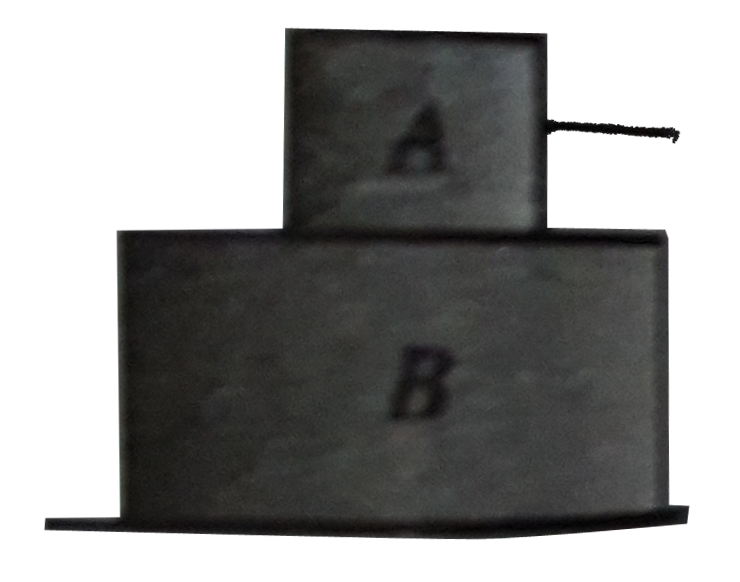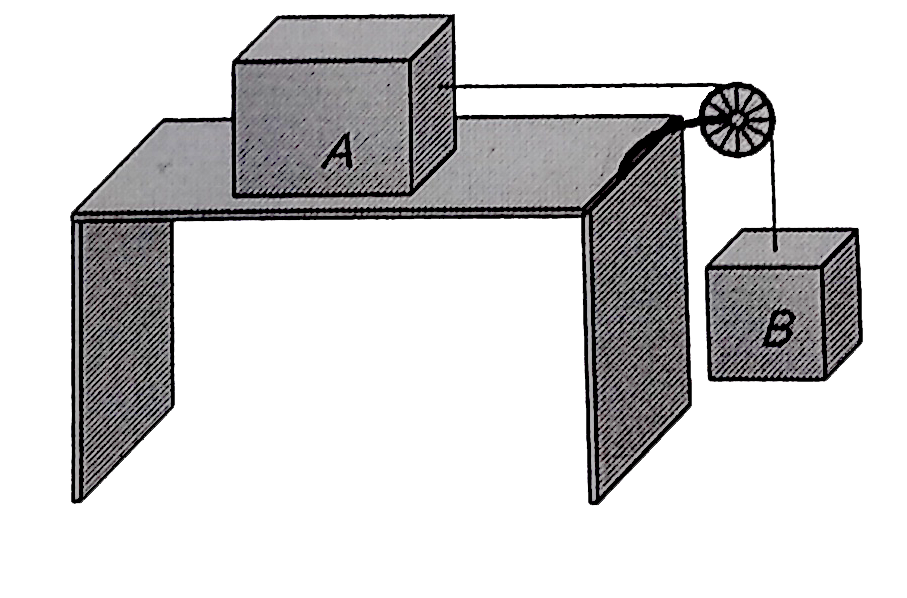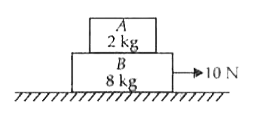A block (A) of mass 20 kg is put on a frictionless surface and another object (B) of mass 2 kg is placed over it. The coefficient of friction between the surface of A and B is 0.25. If a horizontal force of 10 N applied on B, then acceleration of A and B are respectively......

5m/s2 and 0.91m/s2
5m/s2 and 0.5m/s2
2.5m/s2 and 0.2m/s2
2.5m/s2 and 0.25m/s2
The correct Answer is:C

the relative motion between A and B does not take place until applied maximum force is less than the static friction force . So both the object move as they one the single object
Here maximum static friction between A and B is fmax of f=μsN=μsmg
=5N
Here as F>fmax so relative motion between A and B takes place and acceleration of both the object is different
The FBD of both the block is as follow .

From figure (a )
F-f =mB−aB
10−5=2aB
aB=2.5ms−2
From figure ( b)
fmax=mAaA
∴,5=20aA
∴aA=520=0.25ms−2
Topper's Solved these Questions
- LAW OF MOTIONBOOK - KUMAR PRAKASHANCHAPTER - LAW OF MOTIONEXERCISE - SECTION-F (QUESTIONS FROM MODULE)
22 Videos
- LAW OF MOTIONBOOK - KUMAR PRAKASHANCHAPTER - LAW OF MOTIONEXERCISE - (QUESTION PAPER) SECTION-A
5 Videos
- LAW OF MOTIONBOOK - KUMAR PRAKASHANCHAPTER - LAW OF MOTIONEXERCISE - SECTION-D(NCERT EXEMPLAR SOLUTIONS)
42 Videos
- GRAVITATIONBOOK - KUMAR PRAKASHANCHAPTER - GRAVITATIONEXERCISE - QUESTIONS PAPER Section - D
1 Video
- MACHANICAL PROPERTIES OF SOLIDS BOOK - KUMAR PRAKASHANCHAPTER - MACHANICAL PROPERTIES OF SOLIDS EXERCISE - QUESTION PAPER
11 Videos
Similar Questions
A block rests on a rough inclined plane making an angle of 30° with the horizontal. The coefficient of static friction between the block and the plane is 0.8. If the frictional force on the block is 10 N, the mass of the block ((in kg) is .......... (Take g = 10 m/s2)
View SolutionWhat is dynamics?
View SolutionA ball is moving with uniform translatory motion. This means that
View SolutionA spaceship is stationed on Mars. How much energy must be expended on the spaceship to launch it out of the solar system ? Mass of the spaceship = 1000 kg, mass of the sun =2×1030kg, mass of mars =6.4×1023kg, radius of mars = 3395 km, radius of the orbit of mars =2.28×108km,G=6.67×10−11Nm2kg2
View SolutionWhat is called brittle material ?
View SolutionA block A of mass 2 kg rests on another block B of mass 8 kg which rests on a horizontal floor. The coefficient of friction between A and B is 0.2 while that between B and floor is 0.5 .When a horizontal floor F of 25 N is applied on the block B the force of friction between A and B is
View SolutionA block A of mass 2kg is placed over smooth block B of mass 4kg which is placed over a smooth horizontal floor The coefficient of friction between A and B is 0.4 when a horizontal forces of magnitude 10N is applied on A the acceleration of block of A and B are

View SolutionBlock B is placed on a smooth surface. Block A is placed on rough surface of bolck B with coefficient of friction 0.60 . The mass of A and B are 2 kg and 4 kg respectively. Find the frictional force between A and B ( in N )
View SolutionA block A of mass 2 kg rests on another block B of mass 8 kg which rests on a horizontal floor. The coefficient of friction between A and B is 0.2 while that between B and floor is 0.5. when a horizontal force of 25 N is applied on the block B. the force of friction between A and B is
View SolutionThe blocks A and B are arranged as shown in the figure. The pulley is frictionless. The mass of A is 10 kg . The coefficient of friction of A with the horizontal surface is 0.20. The minimum mass of B to start the motion will be

View SolutionA block A of mass 2 kg rests on another block B of mass 8 kg which rests on a horizontal floor . The coefficient of friction between A and B is 0.2 while that between B and floor is 0.5 . When horizontal force F = 25 N is applied on the block B , the force of friction between A and B is (in N) .
View Solution100 किग्रा द्रव्यमान का ब्लॉक A, 200 किग्रा द्रव्यमान के ब्लाक B पर रखा हुआ है तथा चित्र में दिखाए अनुसार एक दीवार से बंधा हुआ है। ब्लॉक A और B के बीच घर्षण गुणांक 0.2 तथा ब्लॉक B और जमीन के बीच घर्षण गुणांक 0.3 है। ब्लॉक B को गति देने के लिये न्यूनतम लगाया गया बल F होगा (g = 10 मी से−2)
View SolutionBlock A of mass 2 kg is placed over block B of mass 8 kg .The combination is placed over a rough horizonatal surface .Cofficient of friction between B and the floor is 0.5 .Coefficient of friction berween A and B is 0.4 .A horizontal force of 10 N is applied on block B .The force of friction between A and B is
(g=10 ms−2)

View Solution10 किग्रा व 15 किग्रा द्रव्यमान के दो गुटके (Blocks) A एवं B को चित्र में दर्शाए गए अनुसार एक-दूसरे के संपर्क में किसी खुरदरी क्षैतिज सतह पर रखा गया है। गुटके व सतह के मध्य घर्षण गुणांक 0.2 है। 200 N के एक क्षैतिज बल को गुटका A पर आरोपित किया जाता है। निकाय का त्वरण है -
(g = 10 मी/सेकण्ड2)

View SolutionBlock B is placed on a smooth surface. Block A is placed on rough surface of block B with coefficient of friction 0.60. The masses of A and B are 2kg and 4kg respectively. The frictional force between A and B (in N) for the situation is nx2 the value of n is.
View Solution2 kg द्रव्यमान का एक गुटका (A), 8 kg द्रव्यमान के गुटके (B) जो कि क्षैतिज टेबल पर स्थिर है, पर रखा हुआ है (A) व (B) के मध्य घर्षण गुणांक 0.2 तथा (B) व टेबल के मध्य घर्षण गुणांक 0.5 है। 25 N का क्षैतिज बल (B) पर लगाया जाये तो (A) व (B) के मध्य घर्षण बल होगा :-
View Solution

